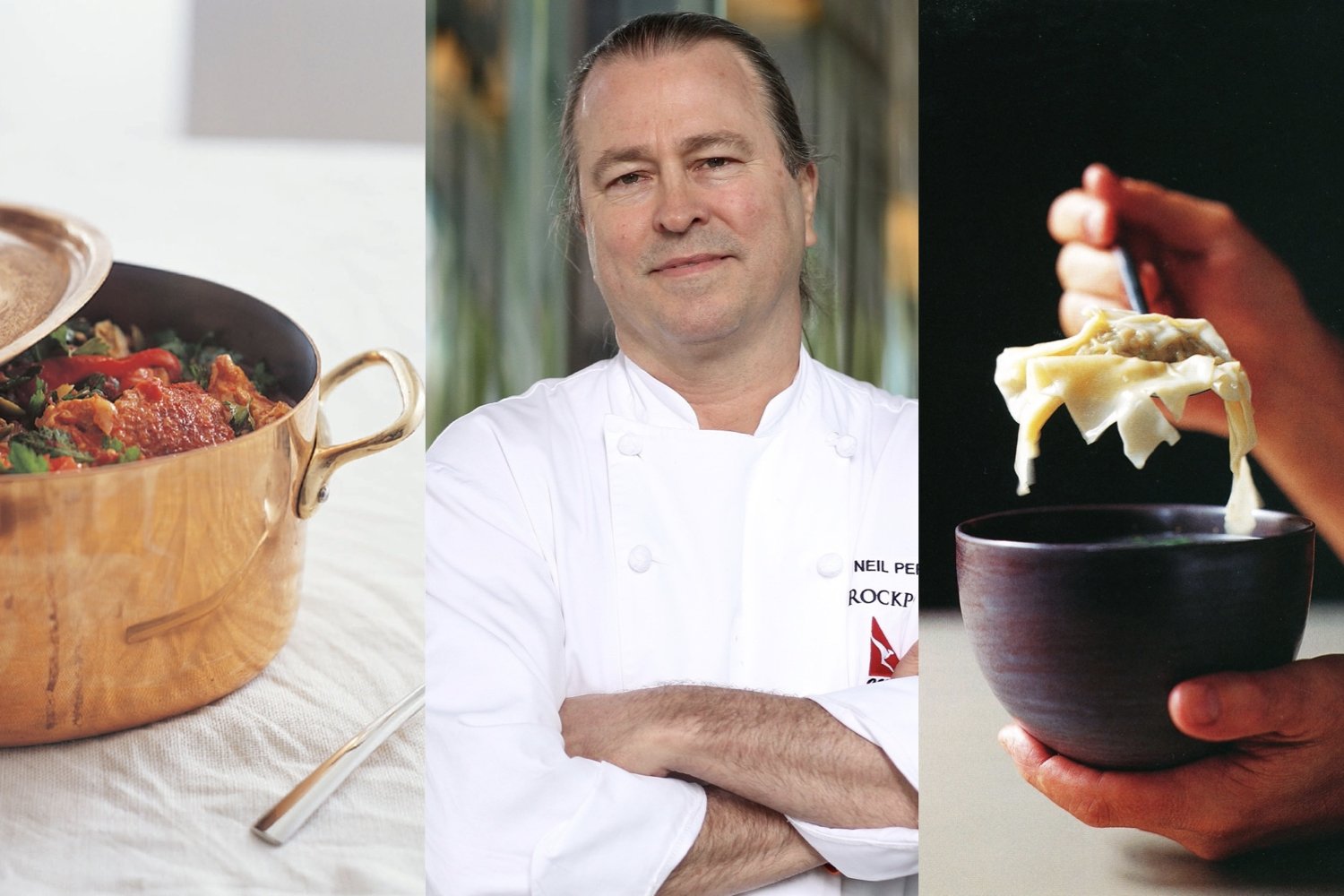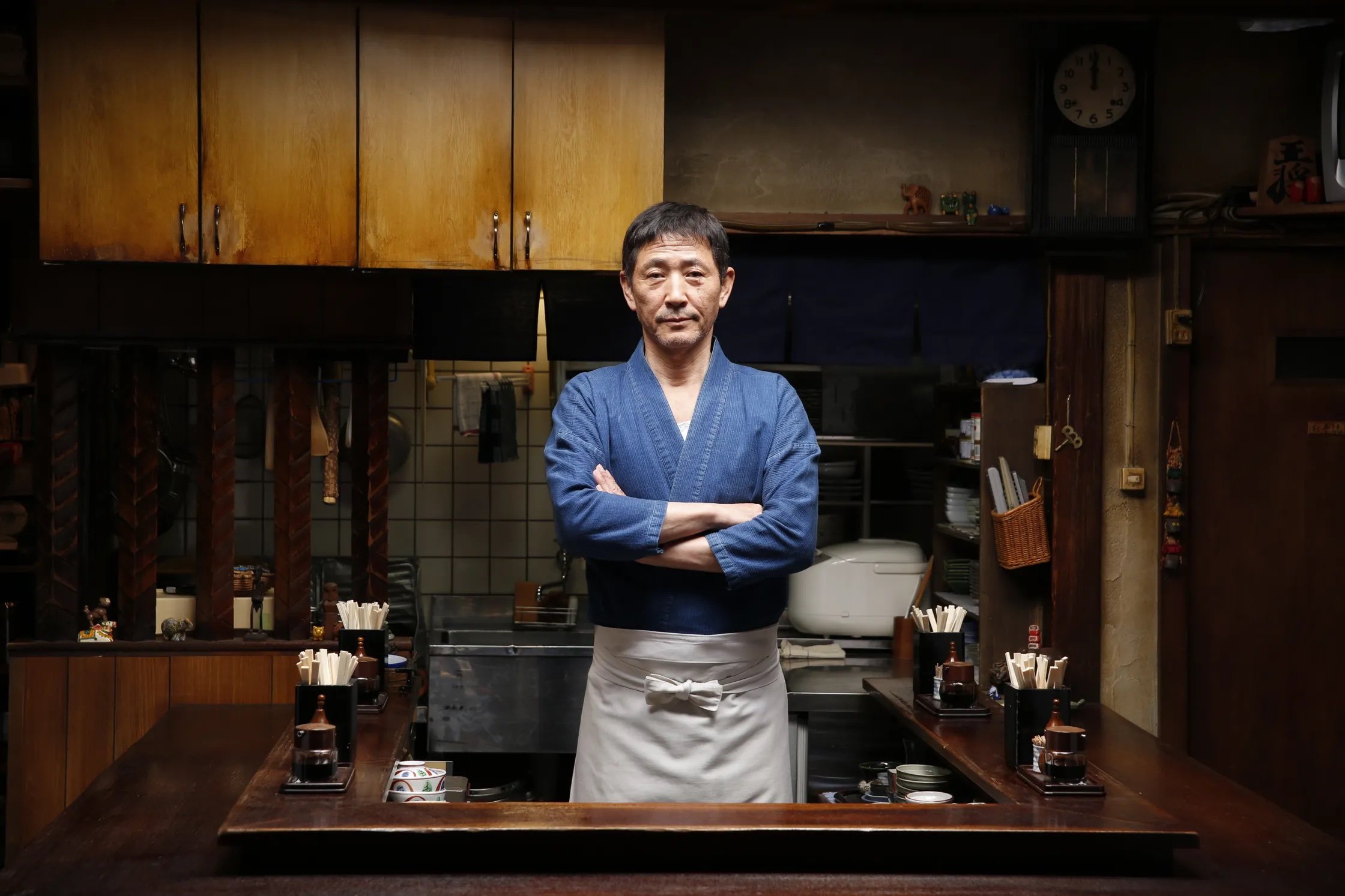Author profile: Tony Bilson
Chef Tony Bilson was at the heart of high-end cuisine in Australia for several decades, with protegés including Neil Perry and Tetsuya Wakuda. We are pleased to add to ckbk both of Bilson’s best-known cookbooks, Tony Bilson’s Recipe Book and Fine Family Cooking, each of which showcase the range and quality of his cooking, and describe how his work was inspired by the classic French chefs. In this profile, Australian food writer Roberta Muir looks at Bilson’s impact on the Australian culinary scene, and picks out a personal selection of recipes from across his illustrious career.
By Roberta Muir
Tony Bilson taught me the joy of cooking whole fish. The baked whole snapper he presented at a cooking class I hosted some 25 years ago was an epiphany. Flavoured simply with Pernod, saffron and herbs, it changed my belief that whole fish was too difficult to cook and bland to eat. I know many home cooks for whom this recipe is still an easy dinner party stand-by. Likewise his cured salmon with olive oil and golden shallots is a lesson in how good produce requires very little adornment.
Referred to as the ‘godfather of Australian cuisine’, Tony died in 2020 after a career spanning more than half a century. His influence on the Australian food scene was profound. He helped shape the way we eat today, through his own cooking and the ongoing influence of the generation of chefs he trained and mentored.
Tony decided on a career in cooking at an early age. Growing up in the early 1960s, by his teens he was an avid and eclectic reader inspired by Escoffier’s Le guide culinaire (Guide to Modern Cookery) and Pierre Andrieu’s Fine Bouche: a history of the restaurant in France. His father was a keen hunter, a pastime shared with his son and which may have led to Tony’s passion for game dishes such as partridge pie and boar with sour cherries. In his memoir, Insatiable, Tony recalls shooting hare with his father and braising it in red wine (jugged hare).
By senior school, Tony was using the family credit account to educate himself by dining in fine Melbourne establishments. This was also the beginning of a lifelong love of great wine. He put as much thought into how his dishes would work with wine, as into the dishes themselves. He had strong opinions on food and wine pairing and cooking with wine, including that fish could be cooked and served with red wine, and red meat with white wine.
At Melbourne’s Café Balzac Tony had his first taste of fresh green asparagus, a rare delicacy in 1950s Australia. It was served with a simple vinaigrette and a potent lesson in the beauty of simplicity that later inspired dishes like green asparagus vinaigrette and artichokes braised in olive oil. Civet de lièvre, another favourite from Balzac, inspired his civet of wild boar to which he adds his own twist of umami-rich anchovies.
Tony’s first hospitality job was in 1965 as a dishwasher at Rhine Castle Cellars in Angel Place, owned by J.K. ‘Johnnie’ Walker, president of the Wine & Food Society and a driving force behind the emergence of gastronomy in Australian culture. The menu was provincial French and, after mastering the scullery, Tony took on more cooking duties under the tutelage of the bistro’s chefs. This training prepared him for his first head chef role at Dee Why RSL Club, where he tried to interest Sydney’s northern beaches locals in bouef Bourguignon as an alternative to T-bone steaks. He returned to Melbourne and worked for Stephanie Alexander at Jamaica House before buying his first restaurant, La Pomme d'Or in Hawthorn. Here he continued the previous owners’ southern French traditions, serving fish soup and goat cheese salad, and received his first favourable reviews.
In 1972, after turning Carlton’s Albion Hotel into one of Australia’s first gastro-pubs – serving terrines, onion soup and roast aged beef – Tony left for Sydney with his partner Gay (Morris) Bilson. Restaurateur Leon Fink offered the young couple free rent on a run-down restaurant in Elizabeth Street in return for providing breakfasts for his Southern Cross Hotel, and Tony’s Bon Goût was born.
Tony’s ability to recreate classic French dishes with a modern twist – like colourful tomato terrine and duck neck en brioche – quickly set Bon Goût apart from the staid French establishments dominating the city. It was a time of change in Australia, with the recent Labor Party victory under Gough Whitlam. Sydney was the place to be and Tony’s Bon Goût, which some credit with launching Australia’s contemporary dining revolution, was a hit with the city’s dining elite from politicians to artists and lawyers to business tycoons. The kitchen was tiny, so everything was bought fresh daily and prepared as simply as possible. Well-made sauces and stocks with great depth of flavour were paired with simply prepared meat and seafood. Live lobsters were kept in the kitchen, something only seen in Chinatown then, for matelote of lobster or simply grilled with herb butter.
In 1976 Tony and Gay ate their way around the most influential restaurants in France. Yet the one that stands out most in his memoirs is Louise Outhier’s L’Oasis, serving light, simple southern French fare such as fillets of red mullet with tapenade. This was, Tony says, “an experience I wanted to share with my customers. I wanted them to feel like I had at L’Oasis – knocked out! … Food would become lighter, more colourful; it was to become art.”
Back in Sydney, Tony and Gay sold Bon Goût to buy a run-down tearoom on an estuary of the Hawkesbury River north of Sydney that would become Australia’s first internationally acclaimed restaurant, Berowra Waters Inn. Here Tony recreated the guest experience he’d discovered in the south of France and developed the concept of a total dining experience that he’d bring to every other restaurant he opened. The Inn had no road access. Guests arrived by punt and were greeted with a glass of Champagne as they stepped ashore. The entrance was designed so the full beauty of the river setting was only revealed as they walked to their table, where they were served bread, butter and olives as they were seated with the menu and wine list.
The prix fixe menu included dishes like the Tripes Lyonnaise Tony first tasted on his recent trip to France, eel from a local fisherman, oysters from a neighbouring lease and quail from a nearby game farm. While Gay was in charge of pastry and became highly regarded for her tartes Tatin and soufflés, Tony’s confit of salmon (inspired by Pierre Koffmann) was one of his most iconic dishes. Many of Sydney’s most celebrated chefs and restaurateurs passed through Berowra Waters Inn including Anders Ousback, Michael and Judy McMahon (of Catalina’s in Rose Bay), and Neil Perry. Tony left the Inn (and Gay) in 1982 and Gay brought Janni Kyritsis up from Melbourne to man the kitchen, launching his Sydney career.
Meanwhile, backed again by Leon Fink, Tony opened Kinsela’s, a brasserie and theatre in a former funeral parlour in Darlinghurst that became one of Sydney’s favourite late night haunts. Here Tony hired a young Japanese kitchenhand then asked him to help in the kitchen. So Tetsuya Wakuda got his first cooking job in Sydney. Tetsuya calls Tony his greatest mentor saying: “His French food was unlike any other I had tasted. I fell in love with his cooking style and took it with me into my dishes.”
Tony wrote his first cookbook in 1987. Tony Bilson’s Recipe Book put classical French technique into an Australian context for the first time. It explained at once the simplicity of cooking and the complexity of taste and texture and is as relevant today as it was almost 40 years ago. Along with Damien Pignolet’s French, it’s one of the best guides to French cuisine for the home cook.
On Australia Day 1988 (Australia’s bicentenary), with the then Prince Charles and Princess Diana as guests of honour, Tony and Leon opened Bilson’s with a barbecue to watch the re-enactment of the tall ships sailing into Sydney Harbour. Bilson’s (today Quay) was in a tower above Sydney’s International Passenger Terminal at Circular Quay with 200-degree views over Sydney Harbour. This theatrical opening set the scene for one of Australia’s most iconic restaurants at a time when dining was the sport of choice for the wealthy. Bilson’s entertained everyone from King Juan Carlos of Spain and Mick Jagger to Paul Bocuse.
It was also the time when Australian chefs began collaborating with producers to source bespoke ingredients. Venison was still wild, not farmed, as were the hares Tony’s butcher sourced from the vineyards. He had Australia’s first milk-fed lambs reared for rack of lamb with tomato Provençal and sourced beef fillets from older cattle to grill and serve with traditional sauce Perigueux and Bordelais. During their short season, pheasants arrived whole, were hung in the cool room for a week, then plucked by apprentices for dishes such pot au feu and classic en salmis.
Stepping back from the excesses of the ‘80s, in 1990 Tony opened Fine Bouche in Palmer Street, East Sydney. This was a simple bistro, more reminiscent of Bon Goût than Bilson’s, which was still owned by Leon and retained the Bilson’s name for some time under rising new chef Guillaume Brahimi before becoming Quay under Peter Gilmore.
Tony’s next restaurant, in 1993, took him back to the opulent world of fine dining. The Treasury, on the top floor of Sydney’s InterContinental Hotel, allowed him to experiment with wider flavours, serving modern food in a classical setting. This was probably the first time kangaroo appeared on a five star hotel menu. More complex dishes like seafood terrine (a jellied bouillabaisse) were offset by the relative simplicity of roast lobster. Whole salmon baked in puff pastry was served tableside from a gueridon trolley.
The early ‘90s saw a big change in produce available in Australia. The Anglo-Celtic population was only just starting to appreciate the wealth of seafood in their waters, beyond fish and chips and buckets of prawns. Quality European cheeses, nut oils and chocolate were now available to home cooks, and the artisanal Australian cheese and olive oil industries were beginning. It seemed the perfect time for a second cookbook for home cooks who now had access to such quality produce. The recipes in Tony Bilson’s Fine Family Cooking, including kangaroo with glazed shallots, mud crab with Champagne sauce and chocolate soufflé, inspired many turn of the century dinner party menus and continue to do so today.
Tony went on to open the multi-million-dollar Ampersand and Commissary kitchen at Cockle Bay, before returning to bistro cooking at Canard in Double Bay. In 2003 he reclaimed the Bilson’s name, opening in the Radisson Plaza Hotel in Sydney as restaurateur-patron while a number of talented young chefs passed through his kitchen inspired by his passion, creative genius and vision of hospitality.
Whether you want to master traditional dishes like crème brûlée and pommes Anna, create more contemporary ones like avocado salad soup or seek inspiration in recipes like fromage blanc with raspberries or baked ficelles with gruyère, reading any recipes in Tony Bilson’s books will teach you something and make you a better cook and diner.
Merci Maestro!
Featured recipes from Tony Bilson
View the full collection
More ckbk features
Roberta Muir reviews the career (and many cookbooks) of the well known Australian chef
Antonia Lloyd reports on the gastronomic joys of exploring this region of France and its renowned food (and wine)
ckbk founder Matt Cockerill selects favorite Japanese comfort foods featured in the cult Netflix series














